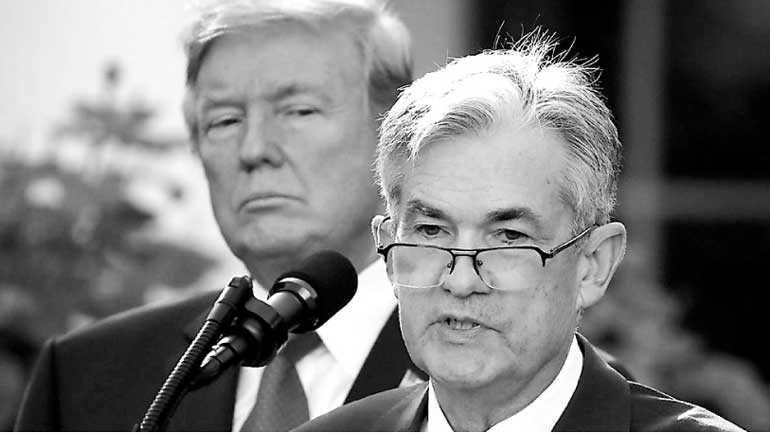Monday Mar 10, 2025
Monday Mar 10, 2025
Saturday, 13 October 2018 00:10 - - {{hitsCtrl.values.hits}}

US President Donald Trump looks on as Jerome Powell, his
nominee to become chairman of the US Federal Reserve, speaks at the White House in Washington, US, 2 November 2017 – Reuters
WASHINGTON (Reuters): A stock sell-off, rising trade tension with China, slower global growth and verbal pressure from the White House are unlikely to dent the US Federal Reserve’s rate hike plans in an economy performing in line with the central bank’s forecasts.
A bumpy 48 hours included an 800 point drop in the Dow Jones Industrial Average and hefty declines in other stock indexes, a forecast of slowing global growth from the International Monetary Fund, and a broadside from President Donald Trump in which he called the Fed “crazy,” “loco,” and “too aggressive” in raising rates.
But data since the Fed’s last meeting in September has been in line with the central bank’s portrait of an economy in which historically low unemployment will be coupled with inflation running near the central bank’s 2% target for the foreseeable future.
Gradual rate increases – moving the overnight federal funds rate over the next year and a half or so from between 2 and 2.5% now to around 3.4% – would slow the economy a bit, but keep inflation in check during a record-setting era of recession-free growth spanning the Obama years and Trump’s first term.
Compared to the recent years in which the Fed has battled both high unemployment and weak inflation, it is a remarkably rosy scenario that, most analysts and officials have said, justifies what the Fed has done so far and offers little reason to shift gears.
Even chief Trump economic adviser Larry Kudlow, qualifying the president’s opinion of Fed chair Jerome Powell’s Fed, said he thought the central bank was “on target,” and that its ability to raise rates was a sign of “economic health, that is something to be welcomed and not feared.”
The unemployment rate in September dipped to 3.7%, a level not seen in nearly half a century, while an inflation report on Thursday indicated the pace of price increases remained under control around the Fed’s target.
Even the sharp rise in long-term bond yields that has spooked equity investors this week is a sign of an economy working more normally than it has since the financial crisis. Indeed depressed long-term rates had led some Fed officials to worry that short-term rates might rise above them and cause the sort of bond yield “inversion” that precedes recession. But the spread between short- and long-term debt is now widening.
Trump’s comments and the stock slide “won’t be enough to prevent the ‘crazy’ Fed from raising rates again in December,” Capital Economics analysts wrote on Thursday after the last consumer price data, which, while slightly below expectations, were still roughly in line with the Fed’s plans.
Forecasters with Macroeconomic Advisers left their outlook for annualised gross domestic product growth unchanged at 3.7% for the third quarter and 2.6% for the fourth quarter.
The Fed has been revising its own growth forecasts higher through the year, as the impact of recent tax cuts and increased federal spending have been felt.
Dramatic and sustained stock market declines can feed into that outlook through a “wealth effect” if they begin to erode household and business confidence, and prompt consumers and investors to curtail spending.
Major U.S. markets were lower again in Thursday afternoon trading, with the Dow and S&P 500 down roughly a half percent each.
But both indexes remain a full 10% higher than following similar dips in February and March. A dip in equities may even take the edge off asset values some Fed officials worry have been “stretched” compared to historic levels.
Among investors in federal funds futures, continued Fed rate hikes remained a solid bet, with a December increase assigned a 78% probability - down only three percentage points from before Wednesday’s market turmoil and Trump’s comments.
Discover Kapruka, the leading online shopping platform in Sri Lanka, where you can conveniently send Gifts and Flowers to your loved ones for any event including Valentine ’s Day. Explore a wide range of popular Shopping Categories on Kapruka, including Toys, Groceries, Electronics, Birthday Cakes, Fruits, Chocolates, Flower Bouquets, Clothing, Watches, Lingerie, Gift Sets and Jewellery. Also if you’re interested in selling with Kapruka, Partner Central by Kapruka is the best solution to start with. Moreover, through Kapruka Global Shop, you can also enjoy the convenience of purchasing products from renowned platforms like Amazon and eBay and have them delivered to Sri Lanka.
Discover Kapruka, the leading online shopping platform in Sri Lanka, where you can conveniently send Gifts and Flowers to your loved ones for any event including Valentine ’s Day. Explore a wide range of popular Shopping Categories on Kapruka, including Toys, Groceries, Electronics, Birthday Cakes, Fruits, Chocolates, Flower Bouquets, Clothing, Watches, Lingerie, Gift Sets and Jewellery. Also if you’re interested in selling with Kapruka, Partner Central by Kapruka is the best solution to start with. Moreover, through Kapruka Global Shop, you can also enjoy the convenience of purchasing products from renowned platforms like Amazon and eBay and have them delivered to Sri Lanka.